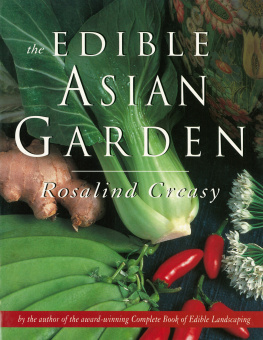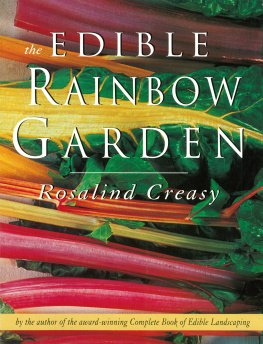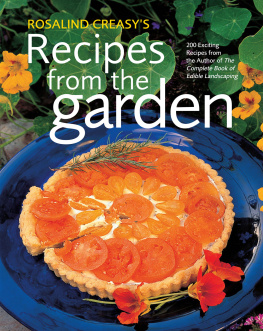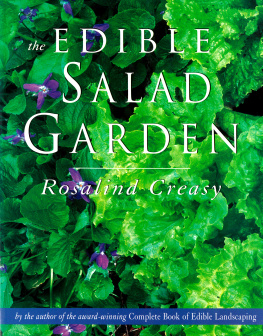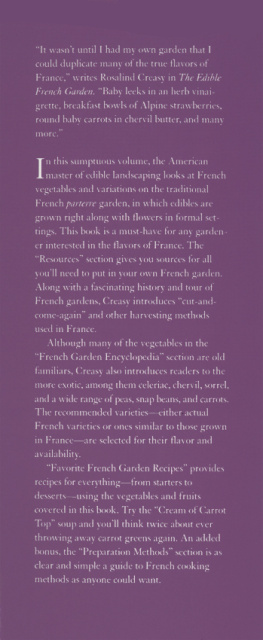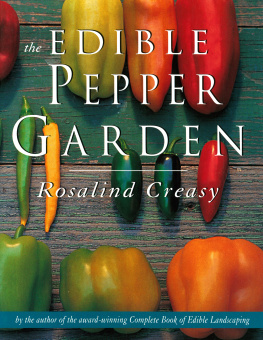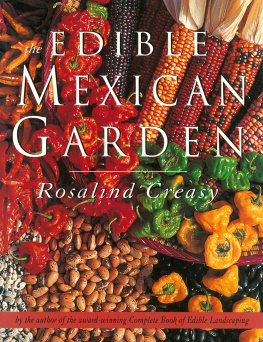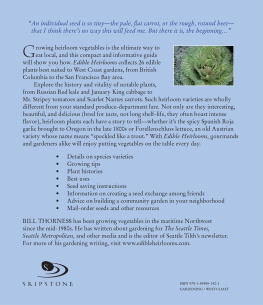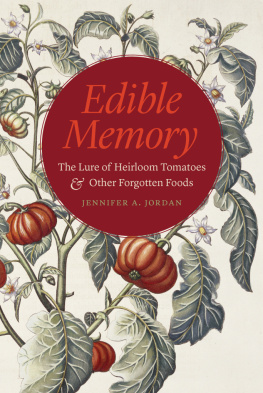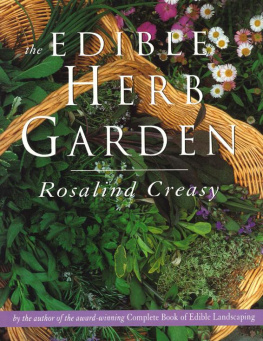Creasy - Edible Italian Garden
Here you can read online Creasy - Edible Italian Garden full text of the book (entire story) in english for free. Download pdf and epub, get meaning, cover and reviews about this ebook. year: 1999, publisher: Tuttle Publishing, genre: Children. Description of the work, (preface) as well as reviews are available. Best literature library LitArk.com created for fans of good reading and offers a wide selection of genres:
Romance novel
Science fiction
Adventure
Detective
Science
History
Home and family
Prose
Art
Politics
Computer
Non-fiction
Religion
Business
Children
Humor
Choose a favorite category and find really read worthwhile books. Enjoy immersion in the world of imagination, feel the emotions of the characters or learn something new for yourself, make an fascinating discovery.
Edible Italian Garden: summary, description and annotation
We offer to read an annotation, description, summary or preface (depends on what the author of the book "Edible Italian Garden" wrote himself). If you haven't found the necessary information about the book — write in the comments, we will try to find it.
Edible Italian Garden — read online for free the complete book (whole text) full work
Below is the text of the book, divided by pages. System saving the place of the last page read, allows you to conveniently read the book "Edible Italian Garden" online for free, without having to search again every time where you left off. Put a bookmark, and you can go to the page where you finished reading at any time.
Font size:
Interval:
Bookmark:
acknowledgments
M y garden is the foundation for my books, photography, and recipes. For nearly twelve months of the year we toil to keep it beautiful and bountiful. Unlike most gardensas it is a photo studio and trial plotit must look glorious, be healthy, and produce for the kitchen all year. To complicate the maintenance, all the beds are changed at leas twice a year. Needless to say, it is a large undertaking. For two decades a quartet of talented organic gardener/ cooks have not only given it hundreds of hours of loving attention, but they have also been generous with their vast knowledge of plants. Together we have forged our concept of gardening and cooking, much of which I share with you in this series of garden cookbooks.
I wish to thank Wendy Krupnick for giving the garden such a strong foundation and Joe Queirolo for maintaining it for many years and sharing his view of Italian cooking with me. For the last decade, Jody Main and Duncan Minalga have helped me expand my garden horizons. No matter how complex the project, they enthusiastically rise to the occasion. In the kitchen, I am most fortunate to have Gudi Riter, a very talented cook who developed many of her skills in Germany and France. I thank her for the help she provides as we create recipes and present them in all their glory.
I thank Dayna Lane for her steady hand and editorial assistance. In addition to day-to-day compilations, she joins me on our constant search for the most effective organic pest controls, superior herb varieties, and the best sources for plants.
Gardeners are by nature most generous. I want to thank Carole Saville, who keeps me up to date, and helped with the more esoteric Italian plants and recipes; and Renee Shepherd of Renees Garden Seeds and Shep Ogden of the Cooks Garden, who are always available to provide vegetable variety information and allow me to prowl their gardens.
I would also like to thank a large supporting cast: my husband, Robert, who gives such quality technical advice and loving support; Nancy Favier for her occasional help in the garden and office; and Susan Freeman for sharing her library of Italian cookbooks.
Many people were instrumental in bringing this book project to fruition. They include Jane Whitfield, Linda Gunnarson, and David Humphrey, who were integral to the initial vision of this book; Kathryn Sky-Peck for providing the style and quality of the layout; and Marcie Hawthorne for the lovely drawings. Heartfelt thanks to Eric Oey and to the entire Periplus staff, especially Deane Norton, Jan Johnson, and Sonia MacNeil, for their help. Finally, I would like to thank my editor, Isabelle Bleecker, for her gentle guidance, attention to detail, and thoughtful presence.
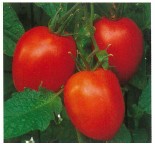
appendix A planting and maintenance
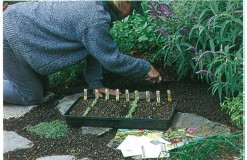
C overed in this section are the basics of planning a vegetable garden, preparing the soil, starting seeds, transplanting, fertilizing, composting, using floating row covers, rotating crops, mulching, watering and installing irrigation, and maintaining vegetables.
Planning Your Vegetable Garden
You can interplant a few Italian vegetables and herbs among your ornamentals, or add them to your existing vegetable garden. If you have no vegetable garden, then you need to design one. The first step in planning your vegetable garden is choosing a suitable site. Most chefs recommend locating the edible garden as close to the kitchen as possible, and I heartily agree. Beyond that, the majority of vegetables need at least six hours of sun (eight is better)except in warm, humid areas, where afternoon or some filtered shade is bestand good drainage. There are only a few Italian edibles that tolerate much shade: Roman mint, arugula, sorrel, and parsley. Annual vegetables need fairly rich soil with lots of added organic matter. They can be planted in rows in a bed by themselvesas part of the classic vegetable garden, saybut some of them, especially eggplants, peppers, radicchios, artichokes, sweet fennel, lettuces, and summer squash, are beautiful and work well interplanted in a flower bed with annual flowers, most of which need the same conditions. In addition, most vegetables can be grown in containers or in large planter boxes.
Once youve decided on where you are going to plant, its time to choose your vegetables. Your major consideration is, of course, what flavors you enjoy using in the kitchen. With this in mind, look for species and varieties that grow well in your climate. As a rule, gardeners in northern climates and high elevations look for vegetables that tolerate cool and/or short-summer conditions. Many vegetable varieties bred for short seasons and most salad greens are great for these conditions. Gardeners in hot, humid areas require plants that tolerate diseases well, and they need to choose heat-tolerant vegetables.
The USDA Plant Hardiness Zone Map has grouped eleven zones according to winter lows. It is a help in choosing perennial plants, but of only limited use for annual vegetables. The new Sunset National Garden Book, published by Sunset Books, gives much more useful climatic information; it divides the continent into forty-five growing zones. Several regional maps describe the temperature ranges and growing season in much detail. The maps are an integral part of this information-packed resource. Of additional interest to the vegetable gardener is the AHS Plant Heat-Zone Map, published by the American Horticultural Society. The heat map details twelve zones that indicate the average number of days each year when a given area experiences temperatures of 86F or higherthe temperature at which many plants, including peas and most salad greens, begin to suffer physiological damage. In Italian Garden Encyclopedia (page ) for information on obtaining the heat map.
In addition to analyzing your climate, knowing what type of soil a particular vegetable needs is equally important. Consider how well your soil drains: is it rich with organic matter and fertility? Poor soil with bad drainage? Is it so sandy that few plants grow well? Find out too what your soil pH is. Nurseries have kits to test your soils pH, and University Extension Services can lead you to sources of soil tests and soil experts. As a rule, rainy climates have acidic soil that needs the pH raised, and arid climates have fairly neutral or alkaline soil that needs extra organic matter to lower the pH. Most vegetables grow best in soil with a pH of about 6.5in other words, slightly acidic. Soil that is below 6 ties up phosphorus, potassium, and calcium, making them unavailable to plants; soil with a pH much over 6.5 ties up iron and zinc. Furthermore, is there hardpan under your garden that prevents roots from penetrating the soil, or water from draining? This is a fairly common problem in areas of heavy clay, especially in many parts of the Southwest with caliche soilsa very alkaline clay. You need answers to these basic questions before you proceed because, to be tender and mild, annual vegetables need to grow fast and with little stress.
Vegetable plants do best with good drainage. Their roots need air, and if the soil stays waterlogged for long, roots suffocate or are prone to root rot. If you are unsure how well a particular area in your garden drains, dig a hole about 10 inches deep and 10 inches across, where you plan to put your garden and fill it with water. The next day fill it again. If it still has water in it eight to ten hours later, you need to find another place in the garden that will drain much faster, amend your soil with much organic matter and mound it up at least 6 to 8 inches above the ground level, or grow your vegetables in containers.
Font size:
Interval:
Bookmark:
Similar books «Edible Italian Garden»
Look at similar books to Edible Italian Garden. We have selected literature similar in name and meaning in the hope of providing readers with more options to find new, interesting, not yet read works.
Discussion, reviews of the book Edible Italian Garden and just readers' own opinions. Leave your comments, write what you think about the work, its meaning or the main characters. Specify what exactly you liked and what you didn't like, and why you think so.


